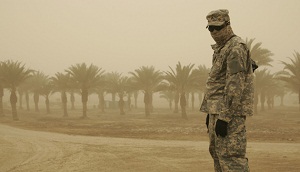War Related Illness and Injury Study Center
Dust, Sand, and Other Airborne Particles
 |
Some service members have health concerns about dust, sand, and other airborne particle exposures. Airborne particles may include dust, sand, dirt, soot, smoke, and liquid droplets. Particles can be suspended in the air for long periods of time.
Service members deployed to the Persian Gulf- or other dusty environments, are often exposed to dust and sand particles. Southwest Asia is known to have some of the highest airborne particulate matter in the world.
In addition to blowing sand and dust, particles may come from a variety of sources including vehicle exhaust, factories, construction sites, farming, unpaved roads, and burning debris.
These airborne particles can enter the body when you breathe. Large particles can be trapped in your nose and throat and are removed when you cough or sneeze. Small particles (i.e., less than 10-micrometers in diameter) may be inhaled into your respiratory tract. If exposed to high levels of particulate matter, you may experience the following:
- Irritation of eyes, nose, throat, and skin
- Cold or flu-like symptoms including cough, runny nose, eye and throat irritation, and shortness of breath
These symptoms are usually short-term and subside when the exposure ends. People with allergies, asthma, or other breathing conditions may have more severe symptoms.
If you are concerned that you have persistent symptoms or health effects from particulate matter exposure during your deployment, we recommend that you discuss this with your physician.
Disclaimer
*Links will take you outside of the Department of Veterans Affairs web site. VA does not endorse and is not responsible for the content of the linked websites.



















